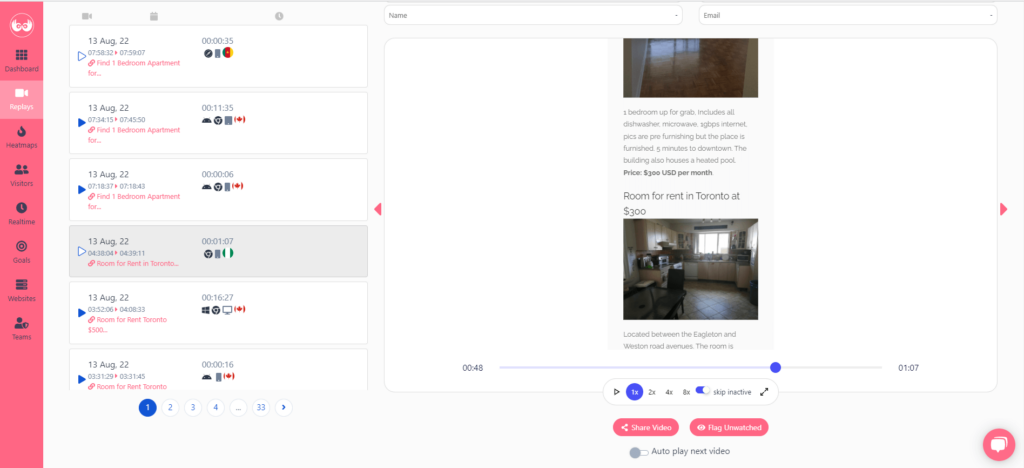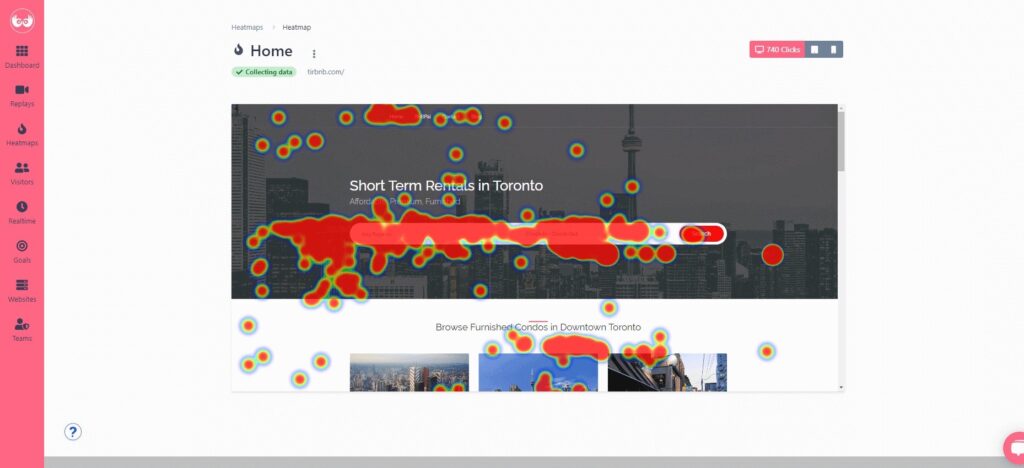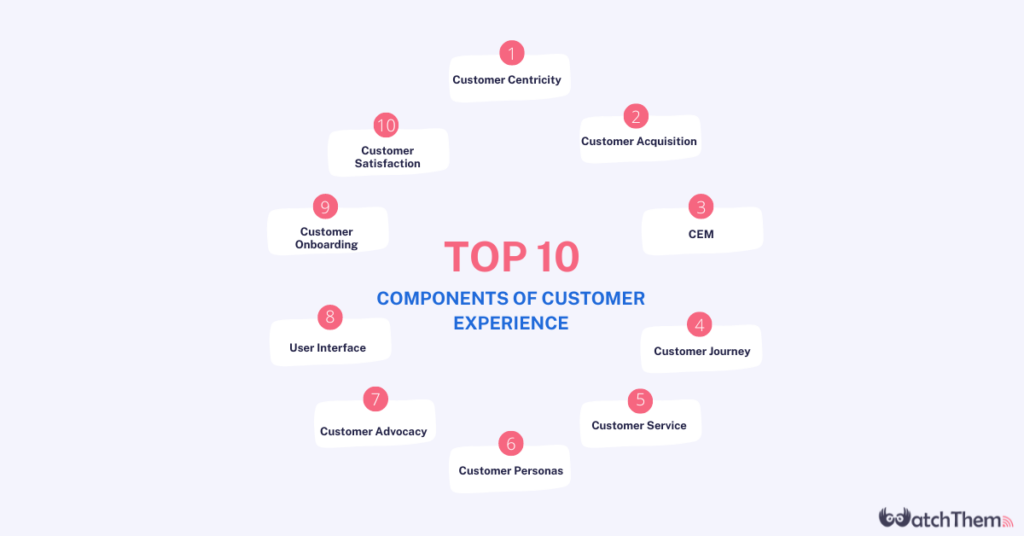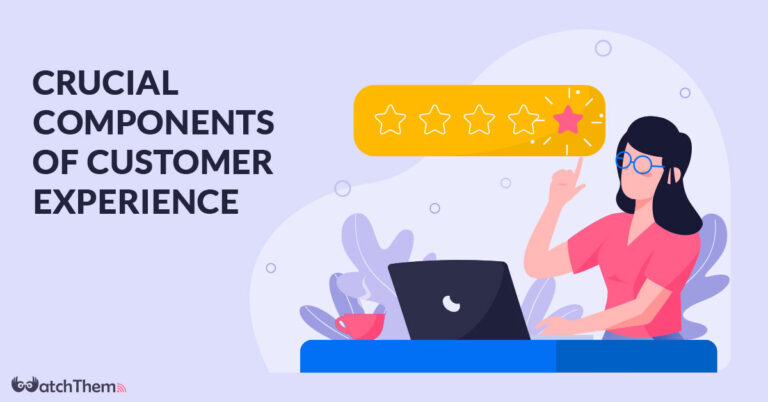Page Contents
In today’s competitive marketing world where the customer is always right, it is not out of mind that customer experience is the lifeblood of companies. Also, an outstanding customer experience highly impacts business outcomes and brings in 5.7 times more revenue. This is why customer-centric companies are 60% more profitable in comparison to companies that don’t focus on customers. Furthermore, customers who stopped using your brand due to poor service costs U.S. companies a total of $1.6 trillion. So in this article, we’ll demystify ten crucial components of customer experience you need to know in order to make changes and increase conversions.
Note: Sometimes, you need a sharp eye to see the cracks in your sales funnel and fix them before customers leave your website. WatchThemLive will assist you in understanding what areas need improvement to improve customer experience. Stay tuned to understand how.
What Is Customer Experience?
Before diving deep into components of customer experience, you need to understand what it means. Customer experience refers to the total impression your customers get from your business. In order to understand better, take a look at these customer experience examples. It’s the pulse of every business and you need to create a CX strategy depending on the size of your business if you want to improve customer experience and fulfill your customers’ expectations.
One of the most practical ways that help you improve your customer experience hands down is to use WatchThemLive. This cost-effective customer experience tool enables you to see whatever you can’t see with your naked eyes. Here are some of their helpful features:
- Session Recordings
Analyzing visitor session replays gives you the opportunity to understand why customers suddenly leave your page or hesitate to convert. WatchThemLive’s session replay tool allows you to record user sessions to see interactions with your website elements. Here are some advantages of using a behavior analytics tool:
- You can watch the customer’s whole journey, so as a digital marketer you’re able to improve the conversion funnel effectiveness and increase your conversion rate.
- As a UX designer, you can understand what distracts your visitors from conversion points and interrupts the customer journey. So you can improve your UX.
- You can also see how customers interact with the product page and increase sales.
- Lastly, the session replay tool lets you to better communicate with your customers, solve their problems, and enhance your customer support.


2. Heatmaps
The website heatmap tool allows you to identify the popular areas on the webpage and test your CTAs in order to measure their effectiveness. In the end, you can find out what satisfies your users and make better decisions.


Any digital marketer, UX designer, and eCommerce manager need to create a positive customer experience, so try WatchThemLive and sign up before your competitors win your customers.
What Are the Ten Components of Customer Experience?
According to recent customer experience statistics, companies with initiatives to improve their customer experience see employee engagement increase by 20% on average. Here, we’re going to discuss ten components of customer experience to help you better understand the benefits of CX and realize where you should mostly put your focus:


1. Customer Centricity
Customer centricity is one of the main components of customer experience. To create a great customer experience, businesses need to put the customer at the center of everything they do and create a powerful customer-focused culture. This is a strategy that businesses use to create the best customer experience. But what steps do you need to take?
First, it’s important to really understand who your customers are and what they want. Take the time to segment your customers and figure out what motivates them. Second, Once you know what your customers want, you must ensure you deliver on your promises. This means meeting or exceeding their expectations every time they interact with your business. Third, the needs of your customers will change over time, so it’s important to constantly evolve your business in order to keep up with their changing needs.
2. Customer Acquisition
In business, customer acquisition is the process of attracting and converting new customers. It’s a key part of growth strategy – without new customers, businesses can struggle to expand. To get new customers, from traditional advertising to more modern approaches like content marketing and social media outreach. No matter what method you use, the goal is always the same: to reach potential customers and convince them to try your product or service.
Acquiring new customers can be challenging, but it’s essential for businesses that want to grow. By using the right mix of methods, you can reach your target audience and convince them to give you a try.
3. Customer Experience Management
A company that wants to create a great customer experience needs to design and manage it carefully at every stage. That’s where customer experience management (CXM) comes in. CXM is the practice of designing and improving customer experience. It encompasses all aspects of the customer journey, from pre-purchase to post-purchase.
Good CXM requires an understanding of customers’ needs and wants, as well as what drives their behavior. It also involves creating systems and processes that deliver an optimal experience at every touchpoint.
4. Customer Journey
One of the important components of customer experience is the customer journey. It is a term used to describe the relationship between a company and its customers. It is the foundation of every company and it is essential to its success. It’s the process that companies use to understand their customer’s needs and expectations, and how they interact with the brand.
In order to create a great customer journey, businesses need to have a deep understanding of their target audience. This means knowing who they are, what they need and want, and how they like to communicate.
Once you have this information, you can start to map out the customer journey. This will help you to see where there are opportunities to improve the experience and make it more seamless.
A great customer journey will result in repeat customers and positive word-of-mouth. It’s important to keep track of customer feedback so you can continue to optimize the journey.
5. Customer Service
Customers are the most important part of any business, and it is their loyalty that keeps it thriving. Customer service is the process of providing support to customers, either through face-to-face interaction or through electronic channels.
The goal of customer service is to ensure that customers are satisfied with their experience and that they receive the level of service they expect. This includes responding quickly to inquiries, resolving issues quickly and efficiently, providing accurate information, and being available when needed. To provide the best possible customer service, companies must clearly understand their customers’
needs and concerns. They must also have a system in place that allows them to track customer interactions and respond to customer inquiries promptly.
A good customer service program ensures that customers have a positive experience, which in turn leads to repeat business and increased revenue. If you have a good customer service program, you can count on your customers to return time and time.
6. Customer Personas
A customer persona (also known as a buyer persona) is a representation of a specific type of customer. It is used when designing and building an interface, defining functionality, or creating marketing material. A customer persona can be used for research and development, as well as to better understand the needs of customers.
To create customer personas, you can use survey data to identify different types of customers and their behavior. Or review past customer feedback or surveys to get a sense of what type of customers exist and how they behave. Or you can draw on your own experiences as a consumer or businessperson to create a persona that represents your ideal customer.
When creating a persona, it’s important to keep in mind that not all customers will fit into one category.
7. Customer Advocacy
Customer advocacy is the practice of supporting and advocating for the interests of customers or clients. Advocates typically work with organizations to identify and solve customer problems, or to improve the customer experience. Customer
advocacy can take many forms, such as providing feedback on products or services, writing letters to management, or participating in online forums.
Customer advocates can have a significant impact on the success of their organizations. By identifying and solving problems early, they help organizations reduce support costs and improve customer satisfaction. In addition, advocates often generate new ideas that can be implemented to improve the customer experience.
While customer advocacy is not a new concept, it is becoming increasingly important as companies compete for customers’ business. By working with an advocate, businesses can create a strong relationship with their customers and support them through difficult times.
8. User Interface
User interface (UI) design is the process of creating an interface that makes it easy for human beings to use a software or hardware product. A user interface is a set of controls, windows, and menus that allow a person to interact with a system. The goal of UI design is to make using the product as simple and efficient as possible for the user.
A user interface can be categorized in many ways, but one common way to group them is by their level of complexity. Basic user interfaces are used by less experienced users and may not have all of the features found in more advanced interfaces. Complex user interfaces are used by more experienced users and may have more features than basic interfaces. User interfaces can also be divided based on how they are displayed onscreen: static or animated.
9. Customer Onboarding
Customer onboarding is helping a new customer get started with their service or product. It can involve setting up an account, completing a questionnaire, and receiving training on how to use the product or service. Customer onboarding can help new customers feel welcome and motivated to use the product or service. It can also help ensure that customers use the product or service correctly and have all the necessary information to do so.
10. Customer Satisfaction
This is the last element of customer experience that we explain in this article. Customer satisfaction is the level of happiness or satisfaction a customer feels after their experience with a company, product, or service.
The customer experience is key to creating satisfied customers. It starts with listening to what your customers want and need and then providing them with the best possible service. Whether ensuring your website is easy to use or responding quickly to complaints, your team must work together to provide an exceptional customer experience.
Conclusion
In conclusion, there are many components of customer experience, and we bring just ten of them to this article. But all of them are important to consider when improving the customer experience. WatchThemLive also works as your right hand and guides you wherever you need it. Make sure to sign up.

